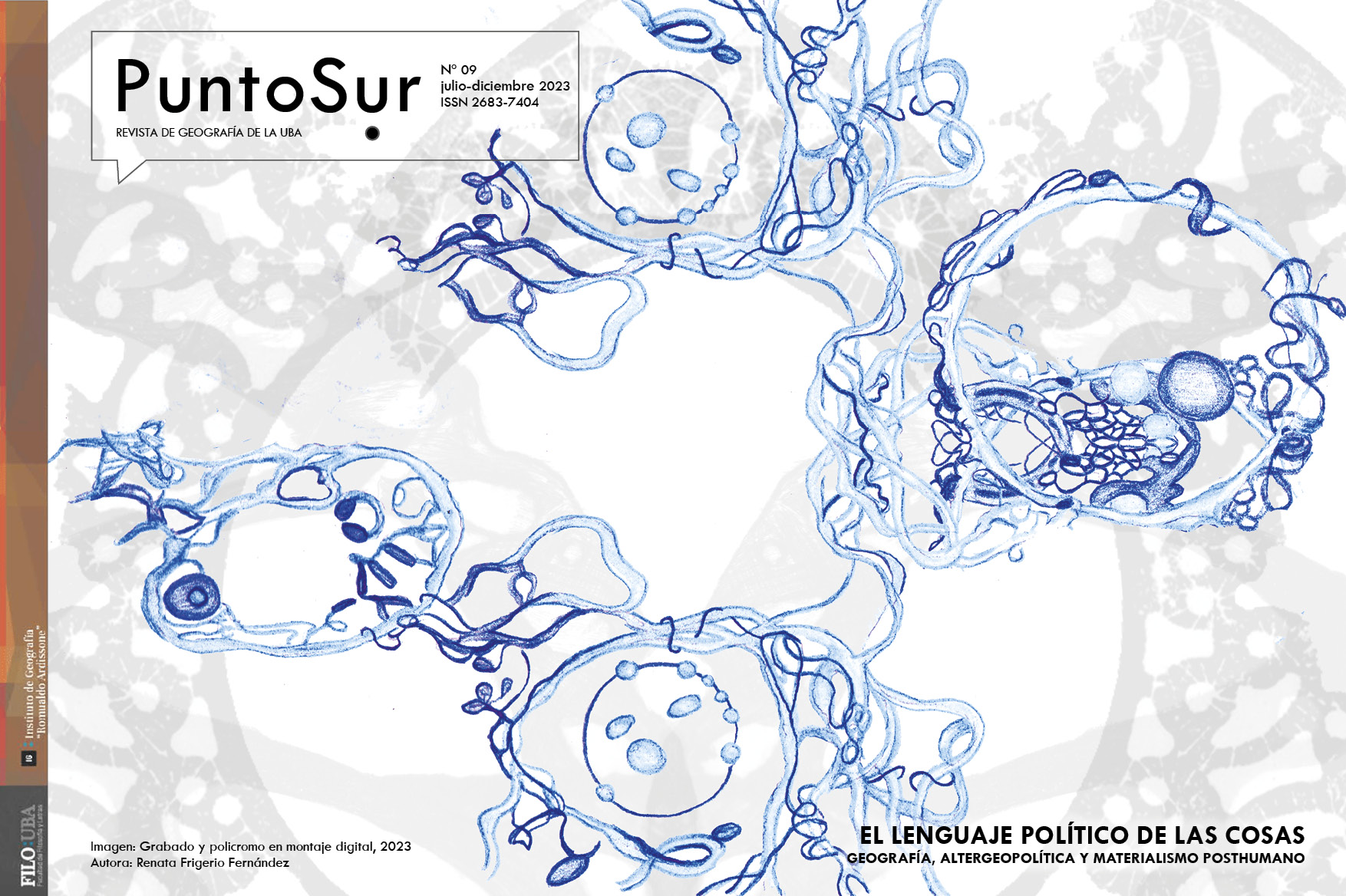Las Posthuman geo-graphies of a larch shingle
Abstract
The larch shingle (fitzroya cupressoides) has been understood from its use, design and cultural interest, being one of the main materials and forms used in the construction of houses, churches and buildings in the south of Chile and in particular in the Chiloé archipelago. However, what is a larch shingle? Or rather, what accumulation of histories, relationships and temporalities does it harbor? The article seeks to deepen, from the vitalist materialism and the posthuman geographies in the network of relations constituted by the forest, territories, a craft trade, the diverse routes that took it to arrive to its destiny and a series of interactions and affective ecologies that go, somehow, strengthening it. From an ethnographic work in the territories inhabited by larches and shingles, the vibrations of a shingle are presented and with it other geographies associated with its vegetal materiality. Given that the larch (alerce) is a tree, endemic to southern Chile and Argentina, protected and declared a natural monument (1976), the shingle, and the associated craft, constitute an increasingly less accessible territory.Downloads
References
Achondo, P.P. (2021). Los lenguajes de la tejuela de alerce y los territorios que no vemos. Cuadernos del Centro de Estudios en Diseño y Comunicación [Ensayos], 134, 71-87.
Achondo, P.P. (2022). Dendrografías, escribiendo con alerces. Revista [sic]. Año XII (32), 148-158. ISSN: 1688-938X.
Achondo, P.P. y Guerrero-Gatica, M. (2022) El bosque y sus habitantes: una discusión teórico-metodológica transdisiplinar del diálogo multiespecies. Revista Etnobiología. Vol. 20(2), 136-151.
Albert, F. (1903). Los bosques en el país. Santiago: Ministerio de Industria y Obras Públicas. Imprenta Moderna.
Barichivich, J. (2022). En Welsh, C. What’s the oldest tree on Earth—and will it survive climate change? National Geographic. https://www.nationalgeographic.com/environment/article/whats-the-oldest-tree-on-earth-and-will-it-survive-climate-change
Barad, K. (2012). On Touching. The Inhuman That Therefore I Am. A Journal of Feminist Cultural Studies, 23(3). doi 10.1215/10407391-1892943.
Bennett, J. (2010). Vibrant Matter: A Political Ecology of Things. Durham: Duke University Press.
Braidotti, R. (2020). El conocimiento posthumano. Madrid: Gedisa.
Braidotti, R. (2022). Posthuman Feminism. Cambridge: Polity.
Coccia (2017). La vida de las plantas. Una metafísica de la mixtura. Buenos Aires: Miño y Dávila.
Coccia (2022). Metamorfosis. Buenos Aires: Cactus.
De la Cadena, M. (2015). Earth beings: Ecologies of practice across Andean worlds. Durham: Duke University Press.
De la Sotta, P. (2009). La tejuela de madera en Chiloé, Chile: Estudio del borde de terminación en los poblados de Achao, Curaco de Vélez y Villa Quinchao. Revista de Urbanismo, 21. https://doi.org/10.5354/ru.v0i21.11
De la Sotta, P. y Lares, L. (2018). La piel de Chiloé un viaje a través del diseño de la tejuela, Informe final Proyecto Fondart Nacional Folio Nº457832, Ministerio de las Culturas las Artes y el Patrimonio, Santiago.
Deleuze, G. y Guattari, F. (2002). Mil mesetas. Capitalismo y Esquizofrenia. París: Pre-textos.
Depetris Chauvin, I. (2019). Geografías afectivas. Desplazamientos, prácticas espaciales y formas de estar juntos en el cine de Argentina, Chile y Brasil (2002- 2017). Pittsburgh: Latin American Research Commons. DOI: https://10.25154/book3
Despret, V. (2022). Habitar como un pájaro. Modos de hacer y de pensar territorios. Buenos Aires: Cactus.
Donoso, C., Lara, A., Escobar, B., Premoli, A. y Souto, C. (2006). Fitzroya cupressoides [Molina] I. M. Johnston. En C. Donoso (Ed.), Las especies arbóreas de los bosques templados de Chile y Argentina: Autoecología (pp. 68-81). Valdivia: Marisa Cuneo.
Escobar, A. (2020). Pluriversal Politics, The Real and the Possible. Durham: Duke University Press.
Escobar, A. (2014). Sentipensar con la Tierra: nuevas lecturas sobre desarrollo, territorio y diferencia. Medellín: Ediciones UNAULA.
Gibson, D. (2018). Towards plant-centred methodologies in anthropology. Anthropology Southern Africa, 41(2), 92-103, DOI: 10.1080/23323256.2018.1468721
Gibson, C. y Warren, A. (2019). Keeping time with trees: Climate change, forest resources, and experimental relations with the future. Geoforum, 110, 325-337. https://doi.org/10.1016/j.geoforum.2019.02.017
Gil-Fournier, M. (2022). Las casas que me habitan. Madrid: Arquitecturas Afectivas Ediciones.
Giraldo, O. F. y Toro, I. (2020). Afectividad ambiental: sensibilidad, empatía, estéticas del habitar. México: El Colegio de la Frontera Sur.
González de Agueros, F. P. (1791). Descripción historial de la provincia y archipiélago de Chiloé. Lima: Imprenta de Don Benito Cano.
Gutiérrez, A. (2016). Árboles monumentales: un patrimonio natural no reconocido en Chile. Bosque, 37(2), 445-449.
Haraway, D. (2016). Staying with the Trouble, Making kin in the Chthulucene. Durham y Londres: Duke University Press.
Ingold, T. (2012). Toward an Ecology of Materials. Annu. Rev. Anthropol, 41, 427-442.
Ingold, T. (2018). La vida de las líneas. Santiago de Chile: Ediciones Universidad Alberto Hurtado.
Lara, A. (1998). Alerces: Gigantes milenarios del bosque chileno. En Defensores del Bosque Chileno (Eds.), La tragedia del bosque chileno (pp. 94-101). Santiago de Chile: Ocho Libros.
Lara, A. (2016). Alerces: Los viejos lentos del bosque. Academia, 19, 30-37.
Lara, A., Fraver, S, Aravena, J.C. y Wolodarsky-Franke, A. (1998). Fire and the dynamics of Fitzroya cupressoides (alerce) forest of Chile’s Cordillera Pelada. Écoscience 6, 100-109.
Lara, A. y Villalba, R. (1993). A 3620-Year Temperature Record from Fitzroya Cupressoides Tree Rings in Southern America. Science, 260, 1104-1106.
Latour, B. (1986). Visualisation and Cognition: Drawing Things Together, Knowledge and Society, 6, 1-40.
Mancuso, S. y Viola, A. (2015). Brilliant Green: The Surprising History and Science of Plant Intelligence. Washington: Island Press.
Marder, M. (2013). Plant-Thinking: A Philosophy of Vegetal Life. Nueva York: Columbia University Press.
Molina, R.; Correa, M.; Smith-Ramirez, C. y Gainza, A. (2006). Alerceros Huilliches de la Cordillera de la Costa de Osorno. Santiago: Andros Impresores.
Myers, N. (2015). Conversations on Plant Sensing: Notes from the Field. Natureculture, 35-66.
Myers, N. (2017). Becoming Sensor in Sentient Worlds: A More-than-natural History of a Black Oak Savannah. En G. Bakke y M. Peterson (eds.), Between Matter and Method. Encounters in Anthropology and Art (pp. 73–96). Londres: Bloomsbury.
Navarro, S. y Oñate, B. (2018). Tala ilegal: la soterrada explotación del alerce. Patagon Journal, 18, 24-31. https://www.patagonjournal.com/index.php?option=com_content&view=article&id=4181%3Atala-ilegal-la-soterrada-explotacion-del-alerce&catid=190%3Aconservation&Itemid=385&lang=es
Palacio, M. I. (2022). La posición de Laudato Si’ en las Humanidades Ambientales. En V. Figueroa Clerici (Coord.), Conversión ecológica. Hacia un compromiso con la ecología. Salta: EUCASA, pp. 23-48.
Saquet, M. A. (2015) Territorialidades y territorialización con autonomía en las prácticas agroecológicas. Rev Fac. Agron., 114(1), 178-189.
Skewes, J. C. (2019). La regeneración de la vida en los tiempos del capitalismo. Otras huellas en los bosques nativos del centro y sur de Chile. Santiago de Chile: Ocho Libros.
Spinoza, B. (2020). Ética demostrada según el orden geométrico. Madrid: Alianza.
Stengers, I. (2011). Cosmopolitics II. Minneapolis: University of Minnesota Press.
Thrift, N. (2008). Non-Representational Theory. Space, politics, affect. Londres: Routledge.
Tsing, A. (2017). Le champignon de la fin du monde: dur la possibilité de vivre dans les ruines du capitalisme. Les empêcheurs de penser en rond. París: La Découverte.
Tsing, A. y Bubandt, N. (2020). Swimming with crocodiles: Nature is avenged by prehistoric animal. Orion, 39(1), 35-42. https://orionmagazine.org/article/swimming-with-crocodiles/
Torrejón, F.; Cisternas, M.; Alvial, I. y Torres, L. (2011). Consecuencias de la tala maderera colonial en los bosques de alerce de Chiloé, sur de Chile (Siglos XVI-XIX). Magallania 39(2), 75-95. https://dx.doi.org/10.4067/S0718-22442011000200006
Tuan, Y-F. (2007). Topofilia. Un estudio de las percepciones, actitudes y valores sobre el entorno. España: Editorial Melusina.
Urbina, X. (2011). Análisis histórico-cultural del alerce en la Patagonia septentrional occidental, Chiloé, siglos XVI al XIX. Magallania, 39(2), 57-73.
Urbina, X. y Barichivich, J. (Eds). [En Prensa]. La sobreviviencia del alerce y su cultura, La historia de los alerzales de la Cordillera Pelada, Chile.
Urrutia-Jalabert, R.; Malhi, Y. y Lara, A. (2015). The Oldest, Slowest Rainforests in the World? Massive Bio-mass and Slow Carbon Dynamics of Fitzroya Cupressoides Temperate Forests. PLoS ONE, 10(9), 1-24.
Vidalou, J-B. (2020). Ser bosques. Emboscarse, habitar y resistir en los territorios en lucha. Barcelona: Errata Naturae.
Viveiros de Castro, E. (2013). La mirada del jaguar. Introducción al perspectivismo amerindio. Buenos Aires: Tinta Limón.
Copyright (c) 2023 Pedro Pablo Achondo Moya

This work is licensed under a Creative Commons Attribution 4.0 International License.

 Important notice
Important notice




















